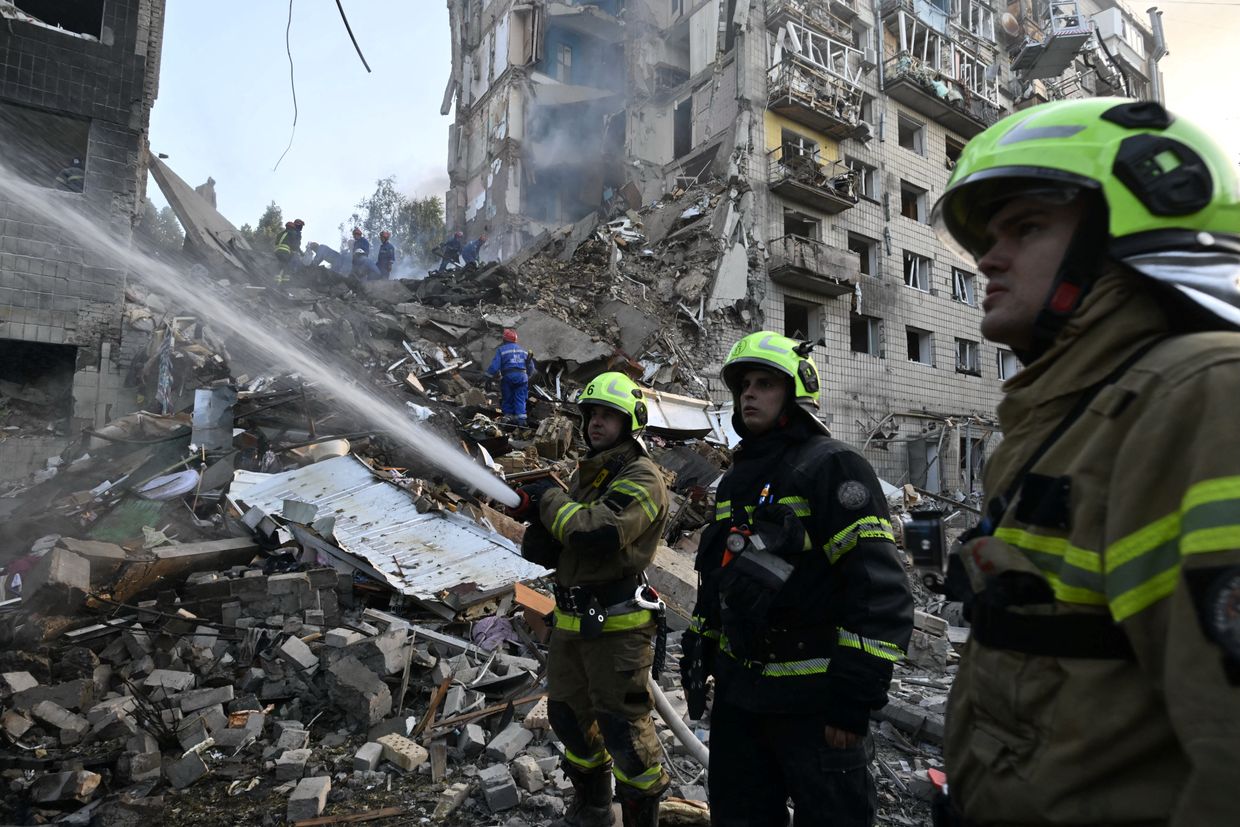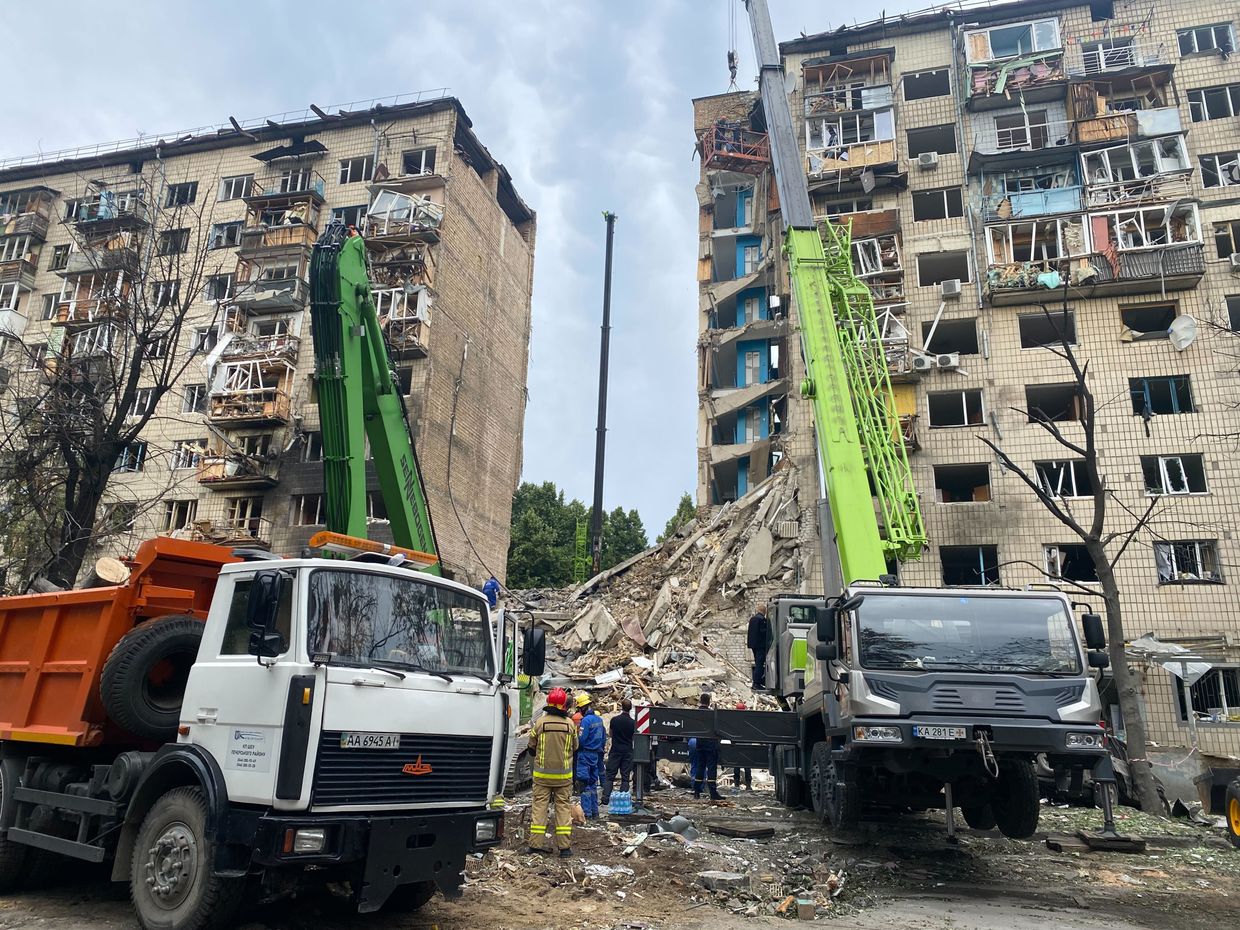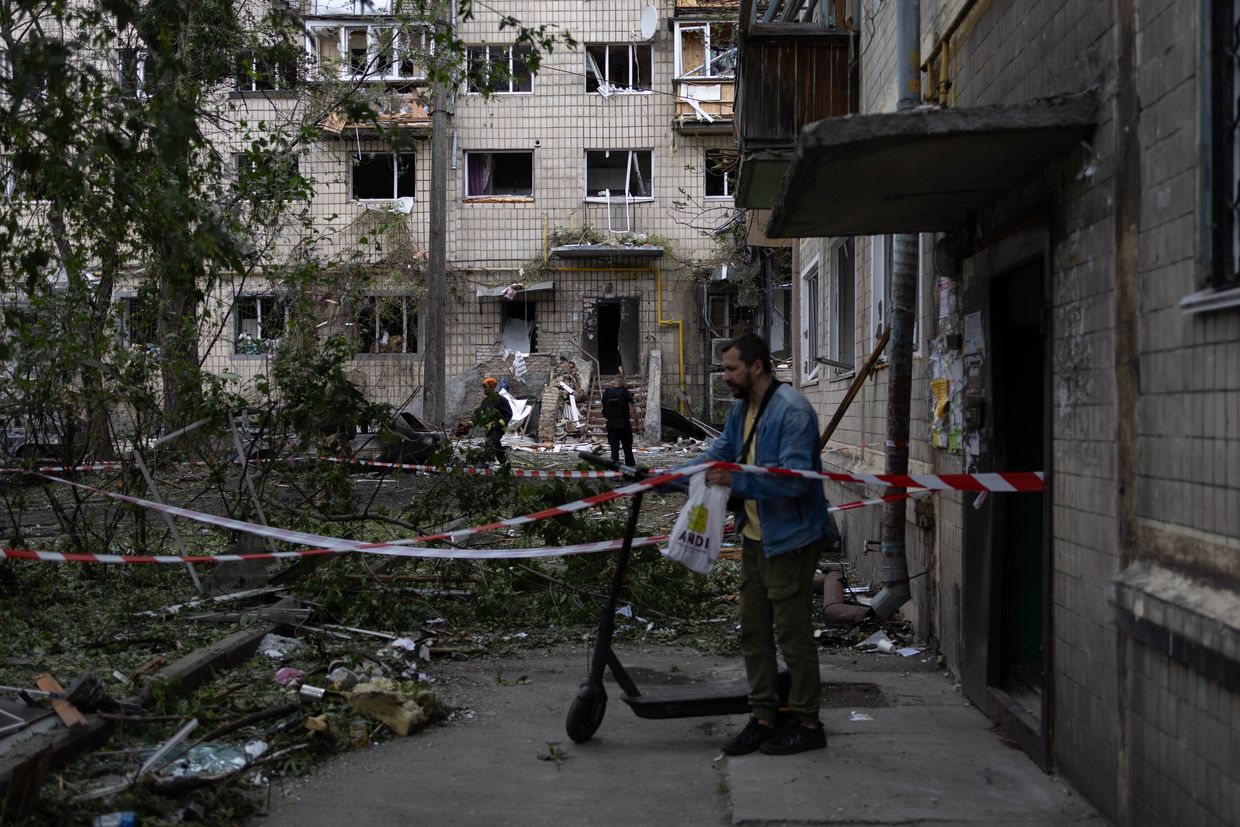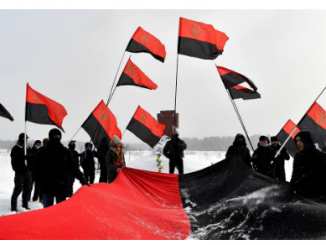
Zhulyany airport in Kiev is burning.
| Published June 17, 2025
In a brutal escalation of hostilities, Russia launched a powerful overnight barrage of drones and ballistic missiles targeting Ukraine’s capital, Kyiv. The attack, which Ukrainian President Volodymyr Zelenskyy described as “pure terrorism,” resulted in at least 10 deaths and 124 injuries, many of them civilians. The strikes also caused extensive damage to civilian infrastructure, including the city’s main airport and several military installations.
A Night of Shock and Fire
The Ukrainian Air Force reported that more than 30 missiles and drones were launched in a coordinated strike from multiple directions late Monday into early Tuesday. At least 14 people were killed according to initial reports, though that number has varied slightly depending on the source. Kyiv’s Mayor Vitali Klitschko confirmed that explosions rocked several districts, including Solomianskyi, where a major transport hub was struck, as well as Dniprovskyi and Desnianskyi.
One of the key targets was Kyiv International Airport (Zhuliany), one of the capital’s two main civilian airports, as well as nearby military installations. Preliminary investigations suggest that Russia used both Shahed drones and Iskander-M ballistic missiles, timed to overwhelm Ukraine’s air defense systems.
“This is Pure Terrorism” – Zelenskyy Reacts
President Zelenskyy, in a somber early morning address, condemned the strikes in the strongest terms.
“They are not attacking military targets. They are attacking our cities, our people, our very existence,” Zelenskyy said. “This is not war. This is pure terrorism.”
Zelenskyy’s statement emphasized a growing international call for further sanctions and defensive aid. “If Russia is allowed to continue striking cities at will, then no nation is safe,” he warned. Ukrainian officials argue that Russia’s intent is psychological warfare—sowing fear, breaking civilian morale, and degrading infrastructure critical to Ukraine’s resistance.
Victoria Smirnova, 37, waits for her father to be pulled up from under the rubble of the house that was struck by a Russian missile in Kyiv, Ukraine on June 17, 2025. (Anna Donets / The Kyiv Independent)
A partially destroyed residential building after a mass Russian missile and drone attack overnight in Kyiv, Ukraine on June 17, 2025. (Katya Denisova/The Kyiv Independent)
The aftermath of the Russian missile attack on a residential building in Kyiv, Ukraine on June 17, 2025. (Anna Donets / The Kyiv Independent)

Firefighters extinguish burning parked cars next to a heavily damaged residential building following the Russian missile strike on Ukraine’s capital of Kyiv on June 17, 2025. (Genya Savilov/AFP via Getty Images)
Widespread Damage and Human Toll
First responders and rescue crews worked throughout the early morning hours to pull victims from the rubble. Hospitals in Kyiv are now on emergency footing, treating dozens of burn victims and those injured by flying debris. Damaged residential buildings, a school, and a shopping center underscore the civilian cost of the strikes.
Ukraine’s Ministry of Internal Affairs confirmed at least 124 people were injured, and several remain in critical condition. Eyewitnesses described terrifying scenes: skies lit up by explosions, the roar of drones overhead, and families rushing to underground shelters.
International Reaction: Where is the Line?
The international community responded swiftly. EU leaders, NATO officials, and U.S. representatives condemned the attack, reiterating support for Ukraine. The UN Security Council has called an emergency meeting to address the deteriorating situation.
However, critics point out that condemnation without stronger action enables continued Russian aggression. Calls for the delivery of F-16 fighter jets and long-range artillery systems have grown louder.
Tactical or Symbolic? Implications of the Attack
Military analysts are divided over whether the latest barrage was a tactical strike aimed at weakening Ukraine’s logistics or a symbolic act of aggression tied to geopolitical messaging. Striking an international airport and hitting dense residential areas may indicate both objectives: disrupting potential NATO logistical pathways while reminding Ukraine—and the world—of Moscow’s reach.
The targeting of military sites adjacent to civilian areas adds a layer of complexity, allowing Russian officials to frame the attack as legitimate while pushing the boundaries of international law.
-
Escalation of Civilian Targeting
The deliberate bombardment of Kyiv’s airport and residential zones indicates a shift in Russia’s operational strategy—from targeting purely military objectives to overt civilian terror. This blurs the line between war and war crimes, signaling a dangerous normalization of attacks on non-combatants. -
Psychological Warfare and Morale Suppression
Labeling the attack as “pure terrorism,” President Zelenskyy highlights its psychological intent. Russia aims to break civilian resolve, destabilize urban life, and push Ukrainians into despair. It’s an attempt to win the war not just on the battlefield but in the hearts and minds of the people. -
Strain on Ukraine’s Emergency Services and Infrastructure
Repeated missile and drone strikes are overwhelming Ukraine’s already stressed infrastructure. Hospitals, first responders, and civil defense units are being pushed to their limits, increasing the country’s long-term vulnerability and economic burden. -
International Law and Possible War Crimes Charges
The scale and nature of the attack raise serious questions under international humanitarian law. Repeated civilian targeting could strengthen war crimes investigations by the International Criminal Court (ICC), adding legal pressure on Russia’s leadership. -
Heightened Global Security Concerns
These attacks reinforce fears that Russia is testing the limits of international tolerance. If allowed to continue unchallenged, it could embolden other authoritarian regimes to adopt similar strategies in future conflicts, destabilizing global norms. -
Increased NATO and EU Pressure to Act
With Ukraine under persistent threat, NATO and EU members face growing public and political pressure to move beyond aid packages and toward stronger military intervention—whether in the form of advanced defense systems, intelligence support, or even a no-fly zone. -
Energy and Economic Ripple Effects
A destabilized Kyiv increases market volatility in Europe, especially in energy and grain supply chains. Insurance costs for regional airlines and trade routes may also spike due to the threat of missile strikes on transit hubs like airports.
Overall Takeaway:
The latest missile and drone barrage on Kyiv marks a chilling evolution in Russia’s war strategy—one that prioritizes terror over tactical military gain. By striking an international airport and heavily populated civilian areas, Moscow is sending a brutal message: nowhere in Ukraine is safe. President Zelenskyy’s condemnation of the attack as “pure terrorism” underscores the true nature of this conflict—not merely a territorial war, but a systematic campaign to break Ukraine’s spirit.
As the death toll rises and infrastructure crumbles, the world faces a pivotal moment. The longer this kind of unchecked aggression continues, the more it erodes international norms, endangers civilians globally, and weakens the credibility of international institutions designed to prevent such atrocities. Kyiv’s suffering must serve as a wake-up call: silence and inaction only fuel the fire.
SOURCES: THE GATEWAY PUNDIT – Russian Missiles and Drones Target Kiev Airport and Other Military Facilities
TEH KYIV INDEPENDENT – ‘A brutal strike’ — Massive Russian missile and drone attack hits Kyiv, killing 10, injuring at least 124
EURONEWS – Russia’s latest deadly drone and missile attack on Kyiv ‘pure terrorism’, Zelenskyy says








Be the first to comment